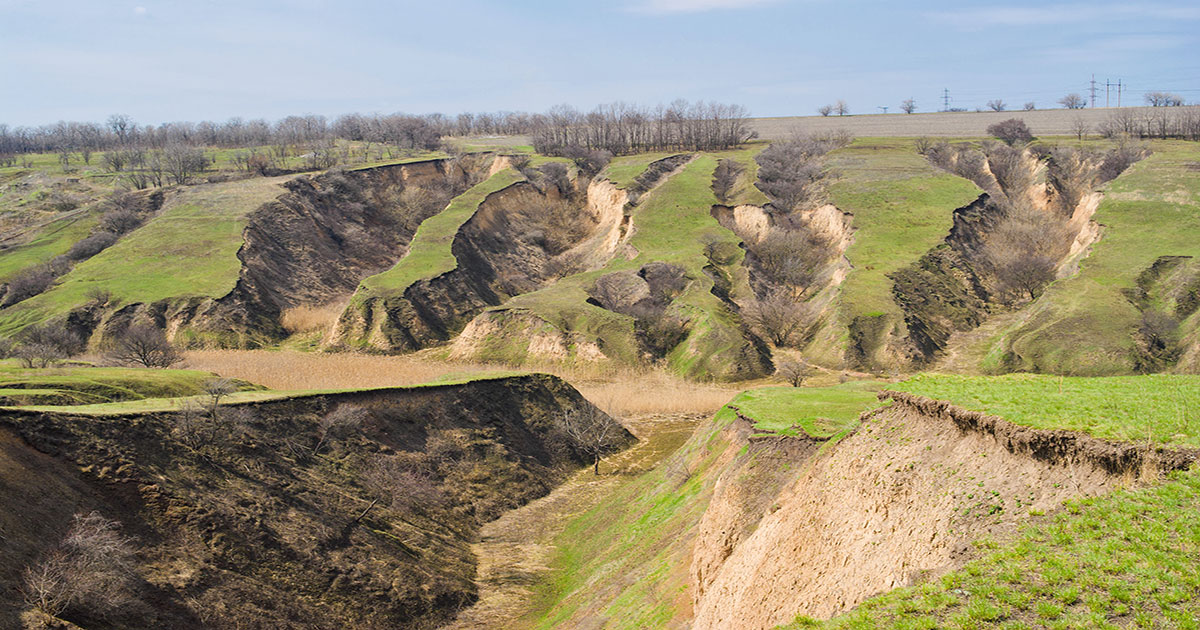
Some might think that erosion only happens during a hurricane. But in fact, erosion is a natural process that happens incessantly, albeit very slowly. National Geographic defines it as a process in which natural forces transport earthen materials and wear them away.
While hurricanes really cause erosion, they’re not the only ones that do. Rainfall, wind, and ice can also produce different types of erosion, particularly in areas close to valleys, beaches, cliffs, and deserts.
Besides being dangerous, soil erosion incurs hefty economic losses as well. A study had estimated that every year, erosion incidents result in $8 billion of global economic loss, diminishing crop yields and increasing water consumption.
Climate change aggravates it, and some countries are suffering grave consequences. Dry seasons have dispersed heavier rains, causing soils to be more vulnerable. And it isn’t helping that land use by humans is getting more excessive, clearing out vegetation and further making our soils fragile.
Who is Most at Risk?
A new map showing the areas most prone to erosion was released some three years ago. It was the first-ever Global Erosivity Map, which used rainfall data of 3,625 stations scattered across 63 countries.
According to the map, Canada, Russia, Northern Europe, and other regions with cold and dry climates have low chances of erosion by rainfall, but erosion by glaciers are more likely. In hot and dry regions, especially those with deserts, such as the USA, Africa, and the Middle East, chances of rainfall erosion are even lower, as they’re only prone to erosion by wind. Wet regions, which include the Amazon, Caribbean sea, and monsoon zones of Central Africa and Asia, have high chances of rainfall erosion. And lastly, regions of temperate climates, like the Mediterranean sea, have quite a high erosivity index, too.
Forces of Erosion
- Rainfall
Rainfall, or liquid water, is the major agent of erosion on the planet. It produces four types of erosion: Splash erosion, which scatters small soil particles as far as two feet; sheet erosion, which is caused by a runoff; rill erosion, which happens as runoff evolves into discrete streams; and gully erosion, the stage where soil particles moved through large channels. Gullies pose as small valleys or fissures during the dry season.
- Wind
The wind is also a powerful erosion agent. They carry sand and produce towering sand dunes, which can go as high as 400 meters.
When windblown sand blasts against a rock with a strong impact, the rock’s surface will wear off, giving it a polished look. Such a thing was the inspiration behind the name “Arches National Park” in Utah.
Wind erosion can be destructive, as well. One of the most prominent examples of such was the dust storms of the 1930s in the US, which eroded tons of valuable topsoil and destroyed agriculture.
- Ice
Glaciers are usually the ice agents of erosion. They drag everything in their path, from sand particles to massive boulders. Many times throughout the earth’s history, glaciers covered parts of the Northern Hemisphere. These glacier periods are what we call “Ice ages.”
Ice age glaciers are also found at the Finger Lakes in New York. But they’re teeming in Greenland and Antarctica the most.
Making Your Home Sturdy Against Erosion
No matter where you live, you must be certain that your home will survive a tornado, hurricane, and of course, soil erosion, which can ensue because of those two.
Your abode must be made up of sturdy materials, which include wood, brick, stone, concrete, iron, and steel.
Wood, however, is vulnerable to moisture and decays over time. It also spreads the fire. So you may opt for brick, instead, as it’s weather-resistant and safe in high heat.
Stone, given its weight, is no doubt durable and long-lasting. But since it’s hard to quarry and is expensive, stone veneers and other synthetic materials are more preferred. They’re usually used in retaining walls and as decorative accents on facades.
Concrete is a by-product of stone and is used on exterior walls, driveways, and foundations. Slabs of it are commonly made as countertops and pavers.
If you use concrete on your driveway or landscape garden, it is crucial to regularly check for cracks, poor leveling, and other signs of damage. Broken concrete may compromise the safety of your home during harsh weather, so have a concrete repair expert that you can call anytime.
Lastly, iron and steel are, of course, essentials. They’re embedded in concrete to make a durable foundation. Some types are 100% recyclable, too, allowing you to save the environment while protecting your property.
Now that we’ve understood erosion and how it happens, keep the knowledge in mind as you choose a place to live and build your dream home.



